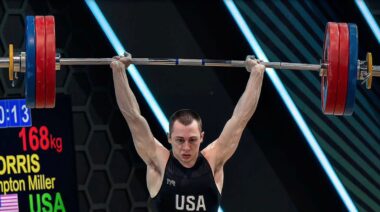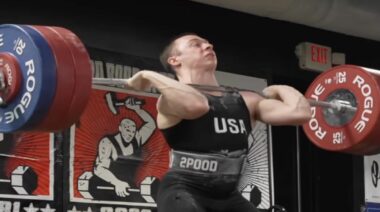I have written previously on how the United States lost its monopoly on weightlifting supremacy in the 1950s. This was a blow to the ego, especially in an era when Soviet Premier Khrushchev threatened to “bury us.” Naturally, when the Soviets also began pulling ahead in the Barbell War and we could not deny it any longer, explanations for this unbelievable slide began to appear. Not all were credible. Lets look at the reasons offered, and what most likely was the real reason behind the regime change.
Secret Exercises
It was assumed by many that the Soviet system was different, way different, from how we trained. This was reiterated in the magazines many times, but seldom were there any explanations of how or why they were different. We simply had to guess, often with comic results. One guess at this included “secret exercises” which were responsible for the astounding performances. When it was discovered that bodybuilding exercises were used in remedial work it was then extrapolated by the Weider magazines that bodybuilding was the secret. York wrote a lot about the significance of good mornings and hyperextensions. These were also remedial exercises but they took on mythical proportions to some. At other times there were photos of Russian lifters throwing snatches skyward over the head and others swinging a dumbbell loaded at one end only. Maybe that was the secret, but the SAID (specific adaptation to imposed demand) principle took a holiday.
Something Better
High protein diets and supplements were de rigueur in the 1950s and 1960s. When the Russians were pulling ahead it was feared that they must have had a better protein utilization supplement than us. Well, in fact they did, but no one imagined that it would be what it was.
Totalitarianism
It was widely assumed that the Russians and others were simply forcing kids to lift, at gunpoint if necessary. This seemed reasonable in the Cold War when we were (still are) struggling to find any lifters at all in a country where freedom of choice was and is sacrosanct. This was later found to be false as they had the task of replacing large numbers of retirees each year.
Huge Numbers
 Also credible were the large numbers of athletes, a population even larger than the U.S., the Russians could recruit and choose from. Lifter number estimates varied. Some approached a million weightlifters alone. If this were true the Russians should have had even higher and more world records than they did. More prosaic estimates put the figure at around 340,000. This seemed reasonable until it was discovered that many athletes were counted more than once (their club, their school, their union, etc). That still worked out to one in every 440 male Russians being a weightlifter. If you take the persons outside the 16-30 age groups it raises to I don’t know how many but clearly it now seems too high. They certainly had more athletes than anyone else but not the huge army that we had assumed. Again, they should have done even better if they had 300,000 athletes. Either that of their much vaunted system was not as efficient as they claimed or we feared.
Also credible were the large numbers of athletes, a population even larger than the U.S., the Russians could recruit and choose from. Lifter number estimates varied. Some approached a million weightlifters alone. If this were true the Russians should have had even higher and more world records than they did. More prosaic estimates put the figure at around 340,000. This seemed reasonable until it was discovered that many athletes were counted more than once (their club, their school, their union, etc). That still worked out to one in every 440 male Russians being a weightlifter. If you take the persons outside the 16-30 age groups it raises to I don’t know how many but clearly it now seems too high. They certainly had more athletes than anyone else but not the huge army that we had assumed. Again, they should have done even better if they had 300,000 athletes. Either that of their much vaunted system was not as efficient as they claimed or we feared.
Technique
Here there was some basis in reality. When the Soviets got into the sport they did a study of technique and made sure their coaches taught proper form. Many American lifters had no coaches and came to the sport in their late teens or even older, so often they were too stiff in the joints to obtain a good low bottom position. In the early days the Soviets used the split technique for their quick lifts. The one whose style they copied was purportedly Norb Schemansky, an American. His style was ironically turned around and used against the American lifters.
Eight-Hour Training Day
Once drugs were taken for granted at elite levels, the rumour mill sometimes had it that Soviet athletes trained eight hours each day. Such was never the case, but it made for a good excuse. In later years the fact that the Bulgarians trained three or more times a day added some belated credibility to this but it was eventually discovered that there were breaks in between each session. In effect this meant that one to two good traditional workouts were simply broken up and taken at regular intervals all through the day, with rest in between. The Eastern Europeans did train more, so there was a lot of truth to this as well. But many American athletes still did not train more than three days a week back then.
 Better Drugs
Better Drugs
In 1960 the U.S. lifters got on the steroid bandwagon. At the time no one knew about it and no one considered it cheating, especially when Cold War athletic supremacy and all the prestige that entailed were at stake. Drug use in those circumstances may even have been seen as patriotic. If “they” used them, so can we. But that usage did not stop our side’s slide and the Soviet rise. Once it was impossible to deny that our side was using drugs to the same extent as the Eastern Europeans and still losing to them, the excuse quickly was revised. “They” simply had to have better drugs, despite the fact that pharmaceutical research was far more advanced on this side of the water.
Ultimately all of these excuses had to be let go. We came to the realization that the Soviets took the lead via better motivators, systematic athletic research, determination with the resources to back that up, and above all lots of hard work by many athletes, coaches, and administrators. This “secret” has now been taken up by many other countries, such as China, Nigeria, India, Iran, Greece, and Turkey. These countries are reaching he point where they are perhaps causing some of the old guard in Moscow and St. Petersburg to look for their own excuses for their decline, just like we did years ago. It has been said and proven many times: there are no “secrets” in sport, only a will to win and a plan of action.
Photos courtesy of Shutterstock.






